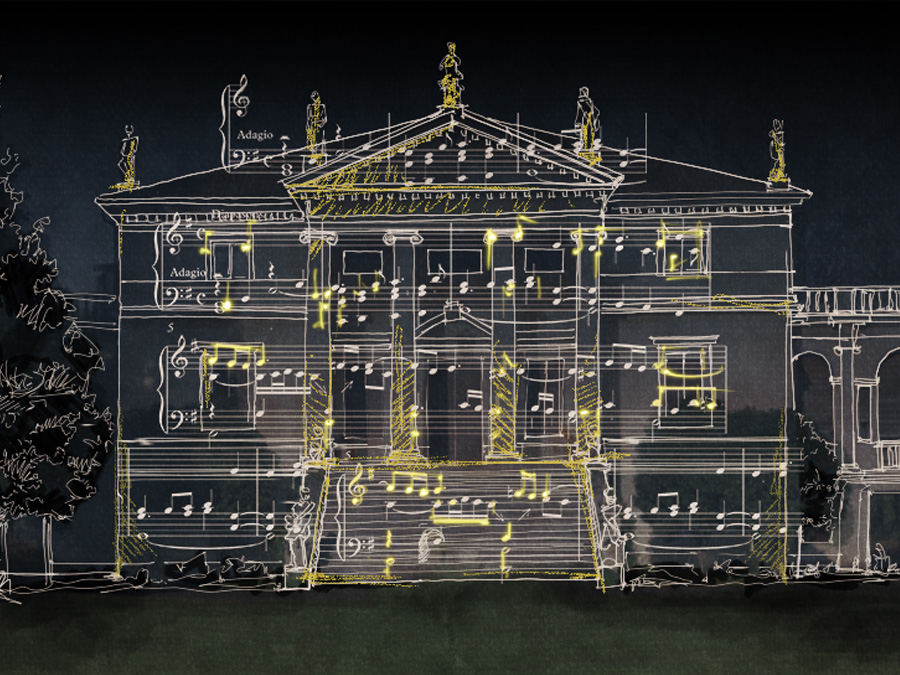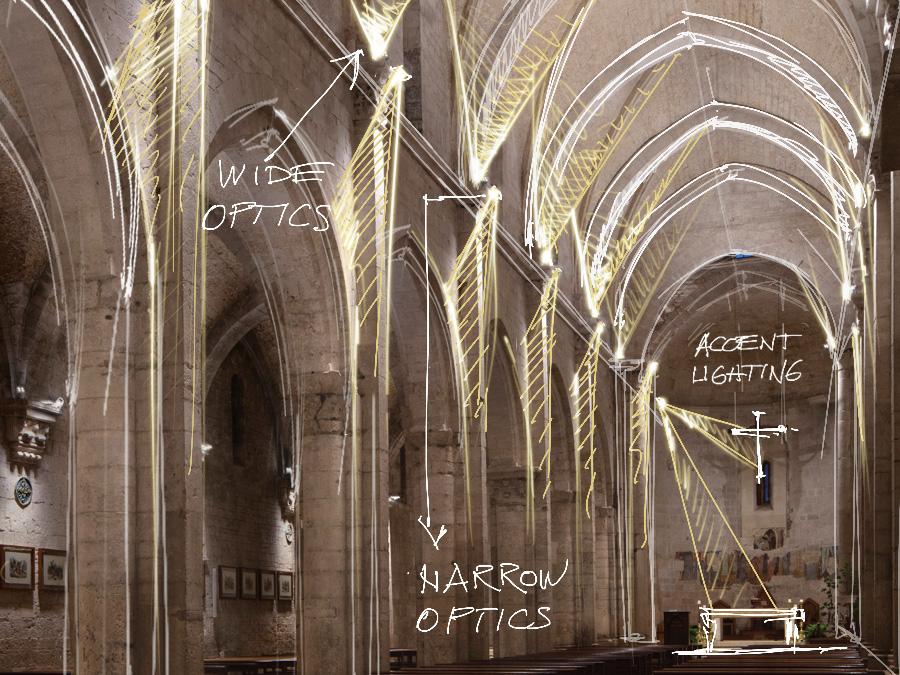Let me show you the way: with these words, we invite someone to follow us as we guide them to their destination. We turn our backs on our companion and start leading the way, possibly with a wave of our hand to indicate where we are heading.
Here at L&L Luce&Light, we like to think that the lighting for outdoor walks and paths plays the same role as that gesture when we are in a new place being guided by a touch of light. Or when, close to home, we aren’t watching where we put our feet while we search for our house keys or answer a message on our mobile. With the corner of our eye, we are aware of the space thanks to the light guiding our inattentive steps.
So let’s start on our way through the pathways here.
Going home
From the main gate to the entrance to stairway C, from the garden gate to the front door, from the intercom at the gate to the entrance hall, we can picture a collage of the paths we repeatedly walk along in our daily lives. The light here has the function of guiding the pedestrian from point A to point B in the shortest possible time.
The shape of the light that anticipates our steps, like the fixtures that emit it, will depend on the architectural structures present and the effect we want to achieve.
Let’s take two different cases: an outdoor walkway not delimited by walls, consisting of a path in concrete, paving stones or tiles, and an outdoor walkway with at least one wall, high or low, to act as border on which LED lighting fixtures can be installed. We’ll start with the latter case and look at some examples of installations by the lighting professionals we work with.

Step Outside 6.3, 3000K, 2W, asymmetrical, satin Go to the project and credits

Pasito 1.0, 3000K, 13W, asymmetrical 150°x90°, grey, distance between fixtures: 3,5 m Find out more about the product
The recessed step lights in these installations fit unobtrusively into the wall structure and have asymmetrical optics that direct the light downwards without any upward light spill, guaranteeing visual comfort for the pedestrian and not wasting light energy where it is not needed.
Despite these similarities, the two applications have very different intentions:
🔶 in one, light areas alternate with shadow, and the effect on the ground is contained due to the use of a low luminous flux (25 lm);
🔶 in the other, the asymmetrical emission lights the path uniformly with no shadow areas, and the luminous flux is much greater (390 lm).
Let’s look at another two examples of walkways flanked by a wall of some form on which small recessed wall fixtures have been installed.

Bright 1.0, 3000K, 2W, diffuse Go to the project and credits

Bright 1.6, 4000K, 2W, diffuse Go to the project and credits
Whether the light is on one or both sides, rather than lighting the ground, here it has the function of demarcating a boundary that, if visibility is poor or we are not paying attention, our eye might not register: a black wall or kerbstones.
Asymmetrical optics are the best choice for the downlight; otherwise, we could use diffuse optics or rotationally symmetrical optics with the addition of an anti-glare accessory, such as the half-serigraphed screen that prevents upward light spill.
In the absence of a wall to attach the fixtures to, bollards are the ideal solution if you want to combine good visibility of the path with ease of installation, an integrated power supply – and an element of design.

Linear 2.1, 4000K, 4W, asymmetrical, anthracite Find out more about the product

Bitta 1.0, 3000K, 10W, asymmetrical, cor-ten Find out more about the product
A quick overview of the bollards we have supplied to our customers over the years shows that the cor-ten finish is very popular, perhaps because it resembles the colour of bark and branches. The bollards could be small, electrical shrubs, 600 or 800 mm tall, pointing the way between the flowerbeds in the courtyard.
If the same optics are used in a taller bollard, they can help the light reach further.

Bitta 1.0, asymmetrical, 600 mm

Bitta 1.0, asymmetrical, 800 mm
💡 📞 💡
And, if you want a bollard in a non-standard height, we are happy to meet your design needs with a customized product
Coming back to the subject of lighting your way home, in the sense of the communal path leading to the main door of an apartment block, here is one final solution: fixtures recessed into the ground.
The first photo shows recessed fixtures that emit radial light, while the other two examples show marker lights installed flush with the ground like stepping stones. We recommend using diffuse optics for the latter effect, with just enough power to light only the covers of the fixtures themselves.
To complete this overview of possibilities for marking apartment-block paths, we’d like to mention a few customized solutions we’ve tailor-made for residential projects:
🔶 small recessed fixtures or linear profiles inserted in a wall-mounted handrail, with the light emission directed towards the wall or the ground;
🔶 an RGBW lighting system to assign a different colour to each pathway;
🔶 projectors mounted on custom-made stakes so that they can emerge from low hedges and be directed towards the path.

💡 📞 💡
Do you have any special requests in mind for your project that you haven’t seen here?
Write to us and put us to the test :)
Grazing light
The shape cast on the ground by the light from radial optics is an impalpable design element whose perspective lines trace the length of the architecture and invite us to walk towards the focal point of our interest: a new area or an entranceway. The cadence of our steps is underscored by the grazing light of the recessed step lights continuing into the distance.
In the photos of the project below, light becomes a stylistic attribute linking different parts of the same residential and commercial complex.

Rondò 2.1, 3000K, 2W, radial, anthracite Go to the project and credits

Rondò 2.1, 3000K, 2W, radial, anthracite Go to the project and credits
At the National Archaeological Museum of Athens, the line of step lights traces a curve that guides visitors to the entrance of the neoclassical building. The light fanning out on the ground gives us an unrestricted view of the imposing facade.
Let’s imagine for a moment how intrusive a row of bollards would have been in this context. We can continue the game and mentally replace with bollards the recessed fixtures and their grazing light in the other two images below. Does it work? How does it change the setting? In the next instalment, we’ll suggest a similar swap on some photos of bollard installations.
Pedestrians this side, cars that side
In the historic centres of towns and cities, we often find ourselves walking in areas without raised pavements. In these cases, different materials differentiate the pedestrian area from the carriageway, visually dividing the two areas.
Clearly, one of the solutions we can use to accentuate this division as night falls is lighting, otherwise we wouldn’t be talking about it here :)
The preferred fixtures for these applications are ones that pass the drive-over test for both load resistance (2000 to 5000 kg) and torsional stress. The drive-over lighting we recommend in these situations is once again a ground-level grazing light, from dome-shaped LED lighting fixtures with a tamper-resistant screw, a sensible precaution in urban environments.
This example shows the lighting for a footway in a small town in Abruzzo in southern Italy, on a street that’s also used by cars. In this case, the lighting planner wanted to customize the fixture’s double beam. A 10° beam is directed towards the carriageway; the second beam, a radial emission, is directed towards the centre of the pavement for the pedestrians.
Walking on water
It has been said that, to take a step forward in life, you have to lose your balance for a moment. When we have a well-lit path ahead of us, however, we feel safe because we can see where we are placing our feet and where we are heading.
So, if our path runs alongside water, we need not fear falling in and instead can enjoy the reflections of the sky.
Light calls to us, light guides us, light contains us: it invites us to move and tells where we can move to.
Examples are recessed fixtures on a pier or a wharf, or along a swimming pool, or linear profiles drawing us along the path leading to the invigorating dip. Whatever the shape of the light and the type of LED fixture, we always recommend paying the utmost attention to the materials used.
🔶 Stainless steel, in particular AISI 316L, is the perfect material for fixtures installed close to water, thanks to its corrosion-resistant properties.
🔶 Thermally conductive technopolymers are also well suited to the task, given their ability to tolerate the various corrosive agents in water. They are resistant not only to substances such as chlorine but also to the sulphur in thermal pools.
In this first part, we were inspired by the lighting effects that guide us to our front door, through a built-up area or near water, and we’ve seen the different shapes that light takes when projected onto the ground from a recessed fixture, step light or bollard.
In the next instalment, we’ll look at the different types of fixtures used to light pathways, their emotional qualities and their installation characteristics.
Have you found a different way to light a path?


















